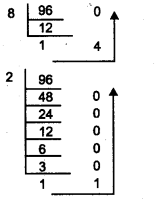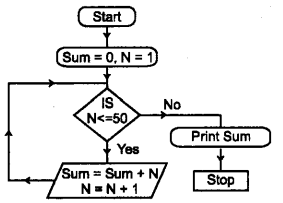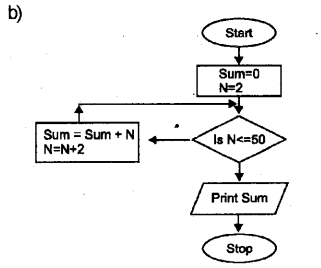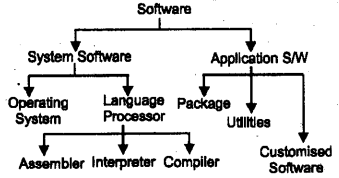Kerala Plus One Computer Application Previous Year Question Paper March 2018 with Answers
| Board | SCERT |
| Class | Plus One |
| Subject | Computer Application |
| Category | Plus One Previous Year Question Papers |
Time Allowed: 2 hours
Cool off time: 15 Minutes
Maximum Marks: 60
General Instructions to Candidates:
- There is a ‘cool off time’ of 15 minutes in addition to the writing time of 2 hours.
- Use the ‘cool off time’ to get familiar with the questions and to plan your answers.
- Read questions carefully before you answering.
- Read the instructions carefully.
- Calculations, figures, and graphs should be shown in the answer sheet itself.
- Malayalam version of the questions is also provided.
- Give equations wherever necessary.
- Electronic devices except non-programmable calculators are not allowed in the Examination Hall.
Answer all questions from question numbers 1 to 5. Each carry one score. (5 × 1 = 5)
Question 1.
Meaningful and processed form of data is known as …………
Answer:
Information
Question 2.
Write the full form of USB.
Answer:
Universal Serial Bus
Question 3.
……….. is a step by step procedure to solve a problem.
Answer:
Algorithm
Question 4.
What is the name of files created to support C++ programs and kept in the standard library.
Answer:
Header files
Question 5.
Find out the odd one from the following:
a) DOS
b) DSL
c) ISDN
d) FTTH
Answer:
DOS. It is an operating system. Others are wired broadband connecting technologies.
Answer any nine from question numbers 6 to 16. Each carries two scores. (9 × 2 = 18)
Question 6.
Despite of the high speed and accuracy computers are said to be the slaves of human beings. Why?
Answer:
- No IQ: It has no intelligent quotient. Hence they are slaves and human beings are the masters. It can’t take its own decisions.
- No feelings: Since they are machines they have no feelings and instincts. They can perform tasks based upon the instructions given by the humans (programmers).
Question 7.
Name the four e-waste disposal methods.
Answer:
e-Waste disposal methods
- Reuse: Reusability has an important role of e-Waste management and can reduce the volume of e-Waste
- Incineration: It is the process of burning e-Waste at high temperature in a chimney
- Recycling of e-Waste: It is the process of making new products from this e-Waste.
- Landfilling: It is used to level pits and cover by thick layer of soil.
Question 8.
What are the features of RAM?
Answer:
RAM (Random Access Memory) is volatile (when the power is switched off the content will be erased) in nature. It is also called Read-Write memory. It is a semiconductor memory. The one and only memory that the CPU can directly access is the main memory at a very high speed. It is expensive hence storage capacity is less.
Question 9.
Problem solving by computer proceeds through different stages. Name the stages in correct order.
Answer:
Phases in Programming:
- Problem identification
- Deriving the steps to obtain the solution
- Coding
- Translation
- Debugging
- Execution and Testing
- Documentation
Question 10.
Write the output of the following C++ expressions. Let a=7, b=2
a) a + b * 3/+ +b;
b) a<=7&&b>1;
Answer:
a) a+b*3/++b = 7+2 * 3/3
(First step: unary ++b is executed, now b=3 and it is used) = 7+6/3(Second step: 2*3=6, this is because * & / are equal priority operators hence operation takes place from the left to right)
= 7 + 2 = 9
Hence the output is 9
b) a<=7 && b>1 = 7<=7 && 2>1
= true && true
= true
The output is true
Question 11.
Detect and correct the errors in the following C++ code.
#include<iostream>
using name space std;
int main();
{
int a, b;
cout<<“,Enter two numbers:”;
cin>>a and b
a + b = c;
cout<<“Sum=”<<c;
return 0;
}
Answer:
Following errors are found
- The space between name and space is an error using namespace std;
- A semicolon(;) after main is an error int main()
- The variable c is not declared int a,b,c;
- The cascaded input operator is not used cin>>a>>b;
- The LHS and RHS are interchanged is an error c=a+b;
Question 12.
Rewrite the following code using switch case statement.
if (Lan = = ‘M’)
cout<<“l prefer Malayalam”;
else if (Lan = = ‘E’)
cout “I prefer English”;
else
cout<<“I prefer neither Malayalam nor English”;
Answer:
switch(Lan)
{
case ‘M’: cout<<“l prefer Malayalam”; break;
case ‘E’: cout<<“l prefer English”; break;
default: cout<<“l prefer neither Malayalam nor English”;
}
Question 13.
There are many advantages in using networked computers instead of stand-alone computers. Write any four advantages of them.
Answer:
The advantages of Networks are given below.
- Resource sharing All the computers in a network can share software (programs, data……) and hardware (printer, scanner, CD drive etc.).
- Reliability: If one computer fails, the other computer can perform the work without arty delay. This is very important for banking, air traffic control and other application.
- Price Vs Performance: A mainframe computer can be 10 times faster than a PC but it costs thousand times a PC. Therefore instead of a mainframe 10 personal computers are used with less cost and same performance.
- Communication Medium: It is a powerful communication medium. We can exchange information between computers in a network.
- Scalable: This means, System performance can be increased by adding computers to a network.
Question 14.
What is the importance of TCP/IP protocol in computer networks?
Answer:
TCP/IP means transmission control protocol or internet protocol. It is a collection of communication protocols used to interconnect network devices on the local networks and the internet. It consists of rule and regulations for how electronic devices (computer, printer, etc) can be connected to the internet and how to transmit data between them.
Question 15.
Write any two drawbacks in using social media.
Answer:
Disadvantages of using social media
- Intrusion to privacy: Some people may misuse the personal information.
- Addiction: sometimes it may waste time and money.
- Spread rumours: The news will spread very quickly and negatively.
Question 16.
e-Business has many possibilities in the business world, but it faces some challenges. Write about any two challenges in e-Business.
Answer:
Challenges to E-Business:
- Peoples are unaware of IT applications and its uses
- Most peoples don’t have plastic money(credit/debit card) and net banking
- It requires high security measurements otherwise you may lose money
- We can’t touch or smell products through online
- Some companies may not have proper Goods delivery service
Answer any nine from question numbers 17 to 27. Each carries three scores. (9 × 3 = 27)
Question 17.
If (M)8 = (96)10 = (N)2, find M and N
Answer:

Here M = 140 and N = 1100000
Question 18.
Following is a flowchart to find the sum of the first 50 natural numbers.
a) Correct the flow chart if there are errors.
b) Redraw the flow chart to find the sum of seven numbers between 1 and 50.

Answer:


Question 19.
What is debugging? Which are the different types of errors that may occur in a program?
Answer:
Debugging The program errors are called ‘bugs’ and the process of detecting and correcting errors is called debugging. In general there are two types of errors syntax errors and logical errors. When the rules or syntax of the language are not followed then syntax errors occurred and it is displayed after compilation. When the logic of a program is wrong then logical errors occurred and it is not displayed after compilation but it is displayed in the execution and testin.
Question 20.
a) What is a token in C++?
b) Distinguish between keywords and identifiers.
Answer:
a) Token: It is the smallest individual units similar to a word in English or Malayalam language. C++ has 5 tokens
b) Keywords: These are reserved words for the compiler. We can’t use for any other purposes Eg: float is used to declare variable to store numbers with decimal point. We can’t use this for any other purpose
Identifier: These are user defined words. Eg: variable name, function name, class name, object name etc…
Question 21.
Data types are necessary to declare variables in C++.
a) What is a data type?
b) Write the classification of fundamental data types in C++.
Answer:
a) The nature of data is different, data type specifies the nature of data we have to store.
b) Fundamental data types: It is also called built in data type. They are int, char, float, double and void
i) int data type: It is used to store whole numbers without fractional (decimal point) part. It can be either negative or positive. It consumes 4 bytes (32 bits) of memory.i.e. 232 numbers. That is 231 negative numbers and 231 positive numbers (0 is considered as +ve) So a total of 232 numbers. We can store a number in between -231 to + 231-1.
ii) char data type: Any symbol from the keyboard, eg. ‘A’ , ‘?’, ‘9’,…. It consumes one byte( 8 bits) of membry. It is internally treated as integers, i.e. 28 = 256 characters. Each character is having a ASCII code, ‘a’ is having ASCII code 97 and zero is having ASCII code 48.
iii) float data type: It is used to store real numbers i.e. the numbers with decimal point. It uses 4 bytes(32 bits) of memory. Eg. 67.89, 89.9 E-15.
iv) double data type: It is used to store very large real numbers. It uses 8 bytes(64 bits) of memory.
v) void data type void means nothing. It is used to represent a function returns nothing.
Question 22.
Write a short note on arithmetic and logical operation in C++.
Answer:
Relational operator: It is a binary operator. It is used to perform comparison or relational operation between two values and it gives either true(1) or false(0). The operators are <,< =,>,>=,== (equality) and !=(not equal to)
Eg. If x = 10 and y = 3 then

Logical operators here AND(&&), OR(||) are binary operators and NOT (!) is a unary operator. It is used to combine relational operations and it gives either true (1) or false(0).
Both operands must be true to get a true value in the case of AND (&&) operation If x = 1 and y = 0 then

Either one of the operands must be true to get a true value in the case of OR(||) operation
If x = 1 and y = 0 then

If x = 1 and y = 0 then

Question 23.
a) Write the equivalent arithmetic operations for the given C++ shorthands.
i) x%=20;
ii) a+=2;
iii) p/=5;
b) What is the difference between a=20 and a==20?
Answer:
a) i) x=x%20;
ii) a=a+2;
iii) p=p/5;
b) i) = is an assignment operator that assigns a value 20 to the LHS (Left Hand Side) variable a. But == is equality operator that checks whether the LHS and RHS are equal or not. If it is equal it returns a true value otherwise false.
Question 24.
Write a C++ program to find the simple interest of an amount (P) deposited with a rate of interest (R) for a period of years (N).
Rate of interest = 7% if deposit amount P is less than 1 lakh.
Rate of interest = 8% if deposit amount P is between 1 and 5 lakhs.
Rate of interest = 9% if deposit amount P is above 5 lakhs.
(Hint: Simple interest = P × N × R/100)
Answer:
#include<iostream>
using namespace std;
int main()
{
float P,N,R,SI;
cout<<“Enterthe Principal amount”;
cin>>P;
cout<<“Enter the number of years”;
cin>>N;
if(P< 100000)
R=7;
else if(P<500000)
R=8;
else
R=9;
SI=P*N*R/100;
cout<<“Simple interest is “<<SI;
}
Question 25.
a) Give the output of the following code
for (i=10; i<30; i+=3)
{
cout<<i<<“\t”;
}
b) Rewrite the code using while loop.
Answer:
a) Output is 10 13 16 19 22 25 28
b) int i=10;
while(i<30)
{
cout<<i<<“\t”;
i+=3;
}
Question 26.
Explain briefly about the wireless broadband connectivity methods used for internet connection.
Answer:
Wireless communication technologies using radio waves
- Bluetooth: This technology uses radio waves in the frequency range of 2.402 GHz to 2.480 GHz. And transmit data in short distance. Mobile phones, Laptops, tablets etc use Bluetooth technology to transmit data.
- Wi Fi(Wireless Fidelity): It uses radio waves to transmit information across a network in a range 2.4 GHz to 5 GHz in short distance. Nowadays this technology is used to access internet in Laptops, Desktops, tablets, Mobile phones etc.
- Wi MAX(Wireless Microwave Access): It uses microwaves to transmit information across a network in a range 2 GHz to 11 GHz over very long distance.
- Satellites: By using satellite we can communicate from any part of the world to any other. The ground stations are connected via satellite. The data signals transmitted from earth to satellite (uplink) and from the satellite to the earth (downlink).
Question 27.
e-Learning allows us to overcome many limitations of conventional teaching-learning process.
a) Name any three e-Learning tools for enhancing e-Leaming process.
b) Write any three advantages of e-Learning.
Answer:
a) Learning tools
- Electronic books reader(e Books): With the help of a tablet or portable computer or any other device we can read digital files by using a s/w is called electronic books reader.
- etext: The electronic format of textual data is called e-Text.
- Online chat: Real time exchange of text or audio or video messages between two or more person over the Internet.
- e-Content: The data or information such as text, audio, video, presentations, images, animations etc, are stored in electronic format.
- Educational TV channels: TV channels dedicated only for the e-Learning purpose: Eg. VICTERS (Virtual Class room Technology on Edusat for Rural Schools OR Versatile ICT Enabled Resources for Students)
b) Advantages of e-Learning:
- It can offer variety courses to large number of students from distant location.
- It saves journey time and money, instructor fees, etc.
- People can enjoy e-Learning with lower cost
- It enables people to do courses conducted by national or international institutions.
Answer any two from question numbers 28 to 30. Each carries three scores. (2 × 5 = 10)
Question 28.
a) Write a detailed classification of software.
b) Some programming languages use compiler whereas some use interpreter. What makes them different?
c) What do you mean by free software?
Answer:

b) Interpreter: This converts a HLL program into machine language by converting and executing it line by line. The first line is converted if there is no error it will be executed otherwise you have to correct it and the second line and so on.
Compiler: It is same as interpreter but there is a difference. It translate HLL program into machine language by converting all the lines at a time. If there is no error then only it will executed.
c) Free and open-source software: Here “free” means there is no copyright or licensing. That is we can take copies of the s/w or modify the source code without legal permission of its vendor (creator). We can use and distribute its copy to our friends without permission. That is Freedom to use, to modify and redistribute.
Question 29.
a) What fs a type conversion? Which are the two ways of type conversion?
b) Define typecasting.
c) Consider the C++ code
int p = 7, q = 2;
float a, b;
a = p/q;
b = (a+q)/q;
Find the values of a and b.
Answer:
a) Type conversion: Type conversions are of two types.
1) Implicit type conversion: This is performed by C++ compiler internally. C++ converts all the lower sized data type to the highest sized operand. It is known as type promotion. Data types are arranged lower size to higher size is as follows.
unsigned int(2 bytes), int(4 bytes), long (4 bytes), unsigned long (4 bytes), float (4 bytes), double(8 bytes), long double (10 bytes)
2) Explicit type conversion It is known as type casting. This is done by the programmer. The syntax is given below.
(data type to be converted) expression Eg. int x = 10;
(float) x; This expression converts the data type of the variable from integer to float.
b) Explicit type conversion It is known as type casting. This is done by the programmer.
c) a = p/q
= 7/2(Here 7 and 2 are integers hence integer division will be took place so answer is 3)
= 3.0 (variable a is float)
b = (a+q)/q
= (3.0+2)/2
= (5.0)/2
= 2.5
Question 30.
a) Define the term topology.
b) Consider that your principal has decided to network your computer lab. Which topology will you suggest? Justify your answer.
c) Differentiate between LAN and WAN.
Answer:
a) Network topologies: Physical or logical arrangement of computers on a network is called structure or topology. It is the geometrical arrangement of computers in a network. The major topologies developed are star, bus, ring, tree and mesh.
b) Star Topology: A star topology has a server all other computers are connected to it. If computer A wants to transmit a message to computer B. Then computer A first transmit the message to the server then the server retransmits the message to the computer B. That means all the messages are transmitted through the server. Advantages are add or remove workstations to a star network is easy and the failure of a work station will not effect the other. The disadvantage is that if the server fails the entire network will fail.
c) Local Area Network (LAN):
This is used to connect computers in a single room, rooms within a building or buildings of one location by using twisted pair wire or coaxial cable. Here the computers can share Hardware and software. Data transfer rate is high and error rate is less, eg:- The computers connected in a school lab.
Wide Area Network (WAN):
This is used to connect computers over a large geographical area. It is a network of networks. Here the computers are connected using telephone lines or Micro Wave station or Satellites. Internet is an example for this. LAN and MAN are owned by a single organization but WAN is owned by multiple organization. The error rate in data-transmission is high.